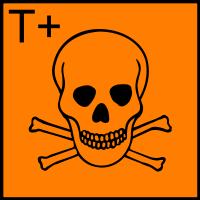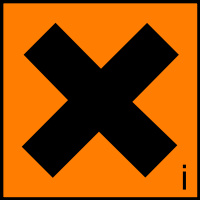|
Storage Condition
|
|
2-8°C, Desiccate
|
 Show
data source Show
data source
|
|
|
Storage Warning
|
|
Moisture Sensitive
|
 Show
data source Show
data source
|
|
|
RTECS
|
|
XZ1400000
|
 Show
data source Show
data source
|
|
|
European Hazard Symbols
|
|
Corrosive (C)
|
 Show
data source Show
data source
|
|
Harmful (Xn)
|
 Show
data source Show
data source
|
 Highly toxic (T+) Highly toxic (T+)
|
 Show
data source Show
data source
|
|
Very toxic (T+)
|
 Show
data source Show
data source
|
 Irritant (Xi) Irritant (Xi)
|
 Show
data source Show
data source
|
|
|
UN Number
|
|
2670
|
 Show
data source Show
data source
|
|
UN2670
|
 Show
data source Show
data source
|
|
|
MSDS Link
|
|
|
German water hazard class
|
|
1
|
 Show
data source Show
data source
|
|
|
Hazard Class
|
|
8
|
 Show
data source Show
data source
|
|
|
Packing Group
|
|
2
|
 Show
data source Show
data source
|
|
II
|
 Show
data source Show
data source
|
|
|
Australian Hazchem
|
|
2X
|
 Show
data source Show
data source
|
|
|
Risk Statements
|
|
14-22-26-34-43
|
 Show
data source Show
data source
|
|
R:36/37/38
|
 Show
data source Show
data source
|
|
R14, R22, R26, R34, R43
|
 Show
data source Show
data source
|
|
|
Safety Statements
|
|
1/2-26-28-36/37/39-45-46-63
|
 Show
data source Show
data source
|
|
26-28-36/37/39-45-46-63
|
 Show
data source Show
data source
|
|
S:28
|
 Show
data source Show
data source
|
|
S1/2, S26, S28, S36/37/39, S45, S46, S63
|
 Show
data source Show
data source
|
|
|
EU Classification
|
|
C10
|
 Show
data source Show
data source
|
|
|
EU Hazard Identification Number
|
|
8B
|
 Show
data source Show
data source
|
|
|
Emergency Response Guidebook(ERG) Number
|
|
157
|
 Show
data source Show
data source
|
|
|
TSCA Listed
|
|
是
|
 Show
data source Show
data source
|
|
|
EU Index
|
|
613-009-00-5
|
 Show
data source Show
data source
|
|
|
GHS Pictograms
|

|
 Show
data source Show
data source
|

|
 Show
data source Show
data source
|
|
|
GHS Signal Word
|
|
Danger
|
 Show
data source Show
data source
|
|
|
NFPA704
|
|
|
 Show
data source Show
data source
|
|
|
LD50
|
|
485 mg/kg (rat, oral)
|
 Show
data source Show
data source
|
|
|
GHS Hazard statements
|
|
H302-H314-H317-H330
|
 Show
data source Show
data source
|
|
H330-H302-H317-H314
|
 Show
data source Show
data source
|
|
|
GHS Precautionary statements
|
|
P260-P280-P284-P305 + P351 + P338-P310
|
 Show
data source Show
data source
|
|
P260-P303+P361+P353-P304+P340-P305+P351+P338-P320-P330-P405-P501A
|
 Show
data source Show
data source
|
|
|
Personal Protective Equipment
|
|
Eyeshields, Faceshields, full-face particle respirator type N100 (US), Gloves, respirator cartridge type N100 (US), type P1 (EN143) respirator filter, type P3 (EN 143) respirator cartridges
|
 Show
data source Show
data source
|
|
|
RID/ADR
|
|
UN 2670 8/PG 2
|
 Show
data source Show
data source
|
|
|
Supplemental Hazard Statements
|
|
Reacts violently with water.
|
 Show
data source Show
data source
|
|
|
Storage Temperature
|
|
2-8°C
|
 Show
data source Show
data source
|
|